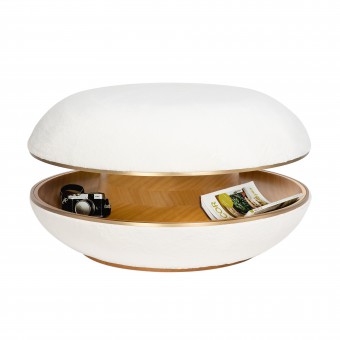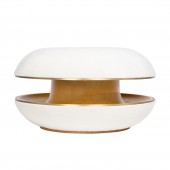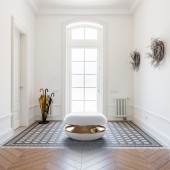
| THE AWARD |
| CATEGORIES |
| REGISTRATION |
| SUBMIT YOUR WORK |
| ENTRY INSTRUCTIONS |
| TERMS & CONDITIONS |
| PUBLICATIONS |
| DATES & FEES |
| METHODOLOGY |
| CONTACT |
| WINNERS |
| PRESS ROOM |
| GET INVOLVED |
| DESIGN PRIZE |
| DESIGN STORE |
| THE AWARD | JURY | CATEGORIES | REGISTRATION | PRESS | WINNERS | PUBLICATIONS | ENTRY INSTRUCTIONS |
Berliner Multifunctional Pouf by Tugce Sonmez Evin |
Home > Winners > Design #144606 >Interview |
 |
|
FS: What is the main principle, idea and inspiration behind your design?
TS: The inspiration behind Berliner was to create a piece of furniture that gives back some of the space it holds. For this purpose, I designed Berliner with a smart storage space in its body.
FS: What has been your main focus in designing this work? Especially what did you want to achieve?
TS: The first objective was to design a comfortable seating unit as it's the main function of a pouf. The second objective was to create extra joy with its cotton-like look and playful yet distinguished solution for storage in open spaces.
FS: What are your future plans for this award winning design?
TS: I am hoping to have Berliner produced by a well-established furniture brand. I think the minimalist design of Berliner is timeless and could be an object of desire with the right approach.
FS: How long did it take you to design this particular concept?
TS: Conceptualization of the design took 3 to 4 months roughly. Many mini-scale prototypes are made in this period, and 2 months of full-scale prototype production after the concept is finalized.
FS: Why did you design this particular concept? Was this design commissioned or did you decide to pursuit an inspiration?
TS: It was an in-house design project following an inspiration that I had. It started as a small container and evolved into a seating unit that can store everyday items.
FS: Is your design being produced or used by another company, or do you plan to sell or lease the production rights or do you intent to produce your work yourself?
TS: I plan to sell or lease the production rights to a brand that I feel confident will value Berliner as I do. I own a Design Studio where I produce and sell my home decor and lighting products, but for furniture, I prefer working with a furniture brand, to be able to provide the best quality to the users.
FS: What made you design this particular type of work?
TS: As modern society evolves, the concept of living spaces has changed. We no longer live in huge houses but rather in smaller spaces that require smart solutions. I wanted to design a furniture that can be multifunctional but does not sacrifice the looks for this matter.
FS: Where there any other designs and/or designers that helped the influence the design of your work?
TS: Designs of the mid-century modern style have influenced the material selection for this work. The form of Berliner can be obtained with a variety of different materials, but I thought the mixed materials of the mid-century modern style would perfectly match the simplistic and organic shape of the design.
FS: Who is the target customer for his design?
TS: Berliner is mainly designed for waiting lounges, office spaces, hotels, and retail stores. It's a perfect seating unit to store and display magazines, books, or any item that is usually left around in a waiting area. Then its use is expanded to houses by achieving the weight limitation to under 50kg.
FS: What sets this design apart from other similar or resembling concepts?
TS: Berliner takes the same space that a similar round pouf would take but creates additional space within the design.
FS: How did you come up with the name for this design? What does it mean?
TS: Berliner takes its name from a famous German pastry that it resembles. Because of its white cotton-like upholstery, the similarity in looks was undeniable, so I decided to put a little smile on the faces of its users by naming it Berliner.
FS: Which design tools did you use when you were working on this project?
TS: I used computer modeling and 3D printing when working with the proportions. It helped me precisely plan the seating angles and curvature of the inner part for storage.
FS: What is the most unique aspect of your design?
TS: Storage within sofas, ottomans, or coffee tables is always explored when designing furniture. Berliner stands out by creating a storage space by not adding elements but subtracting unnecessary fillings by carefully planning the sitting structure and making the storage accessible at any time, not closed by any lids.
FS: Who did you collaborate with for this design? Did you work with people with technical / specialized skills?
TS: I have worked with a very talented craftsman to produce the prototype of Berliner, a woodworker who carved the body of Berliner by hand on a large turning lathe.
FS: What is the role of technology in this particular design?
TS: The inner frame of the pouf is carved in CNC by calculating the approximate weight so that the product can stay within the weight limits of reasonable household use.
FS: What are some of the challenges you faced during the design/realization of your concept?
TS: The main challenge was to create a firm seating unit while controlling its weight. It's carved from laminated wood blocks so it could be heavy. I decided to use the Ayous tree for Berliner because of its lightweight and sturdiness and make a hollow inner frame to eliminate any unnecessary weight.
FS: How did you decide to submit your design to an international design competition?
TS: Berliner was first exhibited in an international design exhibition, Salone Satellite in Salone del Mobile Milano 2022. It received quite positive feedback from many visitors so I wanted to apply to A'Design Award & Competition to see how it would perform. And I am deeply grateful that I did.
FS: What did you learn or how did you improve yourself during the designing of this work?
TS: It was my first furniture design that is actualized, so I learnt a lot about ergonomics in furniture when designing Berliner.
FS: Thank you for providing us with this opportunity to interview you.
A' Design Award and Competitions grants rights to press members and bloggers to use parts of this interview. This interview is provided as it is; DesignPRWire and A' Design Award and Competitions cannot be held responsible for the answers given by participating designers.
| SOCIAL |
| + Add to Likes / Favorites | Send to My Email | Comment | View Press-Release | Translations |




